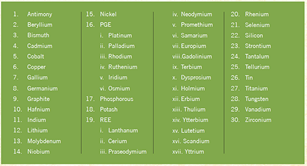

Context
The Centre recently released a list of ‘30 critical minerals’ that it considers essential for economic development and national security of the country.
Key-highlights:
- The list of thirty critical minerals, was identified in a report titled "Report of the Committee on Identification of Critical Minerals" prepared by an expert team constituted by the Ministry of Mines.
- Measures for capacity building: The report also recommends measures for capacity building in the emerging sector of critical minerals.
|
CSIRO is the largest minerals research and development organisation in Australia and one of the largest in the world. |
- Centre of Excellence on Critical Minerals: Establishing a 'National Institute' or 'Centre of Excellence on Critical Minerals' on the lines of Commonwealth Scientific and Industrial Research Organisation (CSIRO).
- CECM will periodically update the list of critical minerals for India, preferably every three years, and notify the critical mineral strategy from time to time.
What is a Critical Mineral?
- A mineral is labelled as critical when the risk of supply shortage and associated impact on the economy is (relatively) higher than the other raw materials.
- Put simply, the report defines critical minerals as “those minerals which are essential for economic development and national security, the lack of availability of these minerals or even concentration of existence, extraction or processing of these minerals in few geographical locations may lead to supply chain vulnerability and disruption".
What are the selected elements?
- The elements/minerals selected as critical have either high economic importance, high supply risk, or have both parameters high.
- A total of 30 minerals were found to be most critical for India, out of which two are critical as fertiliser minerals:
- Antimony, Beryllium, Bismuth, Cobalt, Copper, Gallium, Germanium, Graphite, Hafnium, Indium, Lithium, Molybdenum, Niobium, Nickel, PGE, Phosphorous, Potash, REE, Rhenium, Silicon, Strontium, Tantalum, Tellurium, Tin, Titanium, Tungsten, Vanadium, Zirconium, Selenium and Cadmium.

Import-dependence
- Ten minerals on the list are 100 per cent import-dependent. These are lithium cobalt, nickel, vanadium, niobium, germanium, rhenium, beryllium, tantalum, and strontium.
|
Mineral |
Major Application |
|
Lithium |
Rechargeable batteries, ceramics |
|
Cobalt |
Rechargeable batteries and superalloy |
|
Nickel |
Stainless steel, superalloys, rechargeable batteries |
|
Vanadium |
Alloying agent for iron and steel, batteries |
|
Niobium |
Steel and superalloys, construction, transportation |
|
Germanium |
Fiber optics and nigh vision applications |
|
Rhenium |
Superalloys, aerospace and machinery use |
|
Beryllium |
Alloying agent in aerospace and machinery use |
|
Tantalum |
Electronic components, mostly capacitors and in superalloys |
|
Stronium |
Aluminium pigments and fillers, gas, magnets |
The need
- Required to fulfil requirements and commitments: India needs vast amounts of these minerals for meeting its requirements for energy transition and net-zero commitments.
- Strategic value chains: Critical Minerals forms part of multiple strategic value chains, including clean technologies initiatives such as zero-emission vehicles, wind turbines, solar panels; information and communication technologies, including semiconductors; and advanced manufacturing inputs and materials such as defence applications, permanent magnets, and ceramics.
- Critical for major sectors: Similarly, certain other elements are critical for progress in electronics, defence and agriculture sector.
- Required for effective policy formulation: In the absence of a list of minerals critical for the country, it has been difficult to formulate policy measures to secure the country from supply chain vulnerability of these minerals.
- To deal with global market dynamics: One of the key challenges in the critical mineral supply chain lies in the global market dynamics, which can result in price volatility and supply disruptions.
India’s exploration Update:
- The Geological Survey of India, an attached office of Ministry of Mines, has carried out a G3 stage mineral exploration (fairly advanced) in Salal-Haimna areas of Reasi district, Jammu & Kashmir, and estimated an inferred resource of 5.9 million tonnes of lithium ore.
- Lithium reserves were also discovered on Revant hill in Degana in Rajasthan's Nagaur district by the GSI. It is believed that these reserves can meet 80% of the country's demand.
|
Critical Minerals in major economies:
|


